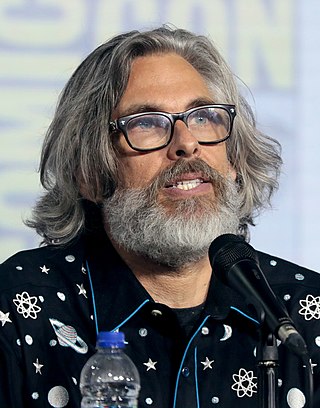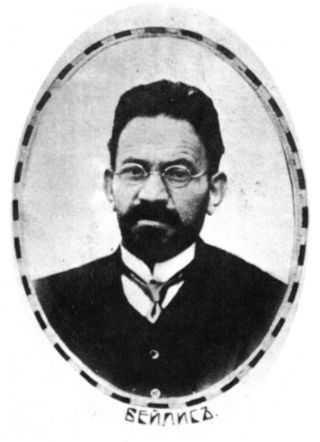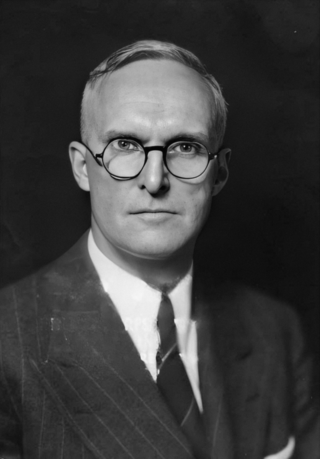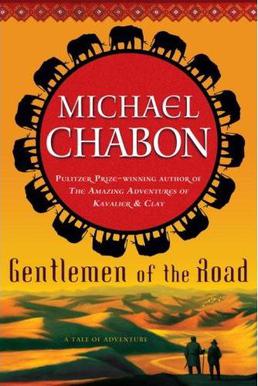
Sitka is a unified city-borough in the southeast portion of the U.S. state of Alaska. It was under Russian rule from 1799 to 1867. The city is situated on the west side of Baranof Island and the south half of Chichagof Island in the Alexander Archipelago of the Pacific Ocean. As of the 2020 census, Sitka had a population of 8,458, making it the fifth-most populated city in the state.

Michael Chabon is an American novelist, screenwriter, columnist, and short story writer. Born in Washington, D.C., he spent a year studying at Carnegie Mellon University before transferring to the University of Pittsburgh, graduating in 1984. He subsequently received a Master of Fine Arts in creative writing from the University of California, Irvine.

The Fixer is a novel by Bernard Malamud published in 1966 by Farrar, Straus & Giroux. It won the U.S. National Book Award for Fiction and the Pulitzer Prize for Fiction.
The Tzadikim Nistarim or Lamed Vav Tzadikim, often abbreviated to Lamed Vav(niks), refers to 36 righteous people, a notion rooted within the mystical dimensions of Judaism. The singular form is Tzadik Nistar.

Menahem Mendel Beilis was a Russian Jew accused of ritual murder in Kiev in the Russian Empire in a notorious 1913 trial, known as the "Beilis trial" or the "Beilis affair". Although Beilis was eventually acquitted after a lengthy process, the legal process sparked international criticism of antisemitism in the Russian Empire.

The Amazing Adventures of Kavalier & Clay is a 2000 novel by American author Michael Chabon that won the Pulitzer Prize for Fiction in 2001. The novel follows the lives of two Jewish cousins, Czech artist Joe Kavalier and Brooklyn-born writer Sammy Clay, before, during, and after World War II. In the novel, Kavalier and Clay become major figures in the comics industry from its nascency into its Golden Age. Kavalier & Clay was published to "nearly unanimous praise" and became a New York Times Best Seller, receiving nominations for the 2000 National Book Critics Circle Award and PEN/Faulkner Award for Fiction. In 2006, Bret Easton Ellis declared the novel "one of the three great books of my generation," and in 2007, The New York Review of Books called the novel Chabon's magnum opus.
In science-fiction criticism, a Jonbar hinge or Jonbar point is the fictional concept of a crucial point of divergence between two outcomes, especially in time-travel stories. It is sometimes referred to as a Jon Bar hinge or change-point.

Anthony Joseph Dimond was an American Democratic Party politician who was the Alaska Territory Delegate in the United States House of Representatives from 1933 to 1945. Dimond was also an early champion of Alaska statehood.
Harkavy is a Jewish surname. Variants in Russian language include Garkavy/Garkavyi, ru:Гарькавый) and Gorkavy. The Dictionary of American Family Names suggests that the surname is derived from the Belarusian word 'harkavyj' for a person who pronounces uvular R instead of voiced alveolar trill R In fact a derogatory epithet for a Jew is "гаркавы", or "burry". Another meaning of the Belarusian word "гаркавы" is "slightly bitter".
Landsman is a surname. Notable people with the surname include:

Jewish-American organized crime initially emerged within the American Jewish community during the late 19th and early 20th centuries. In media and popular culture, it has variously been referred to as the Jewish Mob, the Jewish Mafia, the Kosher Mob, the Kosher Mafia, the Yiddish Connection, and Kosher Nostra or Undzer Shtik. The last two of these terms are direct references to the Italian cosa nostra; the former is a play on the word for kosher, referring to Jewish dietary laws, while the latter is a calque of the Italian phrase 'cosa nostra' into Yiddish, which was at the time the predominant language of the Jewish diaspora in the United States.
There were several proposals for a Jewish state in the course of Jewish history between the destruction of ancient Israel and the founding of the modern State of Israel. While some of those have come into existence, others were never implemented. The Jewish national homeland usually refers to the State of Israel or the Land of Israel, depending on political and religious beliefs. Jews and their supporters, as well as their detractors and anti-Semites have put forth plans for Jewish states.

Gentlemen of the Road is a 2007 serial novel by American author Michael Chabon. It is a "swashbuckling adventure" set in the khaganate of Khazaria around AD 950. It follows two Jewish bandits who become embroiled in a rebellion and a plot to restore a displaced Khazar prince to the throne.
The Slattery Report, officially titled The Problem of Alaskan Development, was produced by the United States Department of the Interior under President Franklin D. Roosevelt's secretary Harold L. Ickes in 1939–40. It was named after Undersecretary of the Interior Harry A. Slattery. The report, which dealt with Alaskan development through immigration, included a proposal to move European refugees, especially Jews from Nazi Germany and Austria, to four locations in Alaska, including Baranof Island and the Matanuska-Susitna Valley. Skagway, Petersburg and Seward were the only towns to endorse the proposal.

Baranof Island is an island in the northern Alexander Archipelago in the Alaska Panhandle, in Alaska. The name "Baranof" was given to the island in 1805 by Imperial Russian Navy captain U. F. Lisianski in honor of Alexander Andreyevich Baranov. It was called Sheet’-ká X'áat'l by the native Tlingit people. It is the smallest of the ABC islands of Alaska. The indigenous group native to the island, the Tlingit, named the island Shee Atika. Baranof island is home to a diverse ecosystem, which made it a prime location for the fur trading company, the Russian American Company. Russian occupation in Baranof Island impacted not only the indigenous population as well as the ecology of the island, but also led to the United States' current ownership over the land.
Nikolay Yakovlevich Rosenberg was an officer of the Imperial Russian Navy who was appointed as Chief Manager of the Russian-American Company, effectively Governor of Russian America, serving from 1850 to 1853. He was replaced before the end of the usual 5-year term because of his difficulties in managing relations with the native Tlingit peoples, who were important to the Russian fur trade and their survival. He may also have been called back to Russia to serve in the Crimean War, which included naval actions.
The history of the Jews in Alaska began before the Alaska Purchase in 1867. Jews from Imperial Russia lived there periodically as fur traders, and a Jewish community has existed since the 1880s. The Klondike and Nome gold rushes attracted Jews to Alaska to seek their fortunes as miners and businessmen and resulted in the first organized Jewish communities. In the Nazi period, Jewish refugee resettlement in Alaska was seriously considered by the government, but after facing backlash, never came to be. Alaskan Jews played a significant role in business and politics before and after statehood, and have included mayors, judges, senators and governors. Today, there are Jews living in every urban area of the state.
Hesh Kestin is an American journalist and novelist. Kestin describes his novels as "fiction hung upon a framework of the real".
Operation Alaska, Finalaska or New Finland was a proposed plan by some US officials to take Finnish refugees into Alaska if the Soviet Union would have conquered Finland. There were plans to take Finns into Alaska, both during the Winter War and the Continuation War. New Finland would have been established in Central Alaska around the Tanana River.
The following is a list of unproduced Coen brothers projects in roughly chronological order. During their long careers, American filmmakers Joel and Ethan Coen have worked on a number of projects which never progressed beyond the pre-production stage under their direction. Some of these productions fell in development hell or were cancelled.








